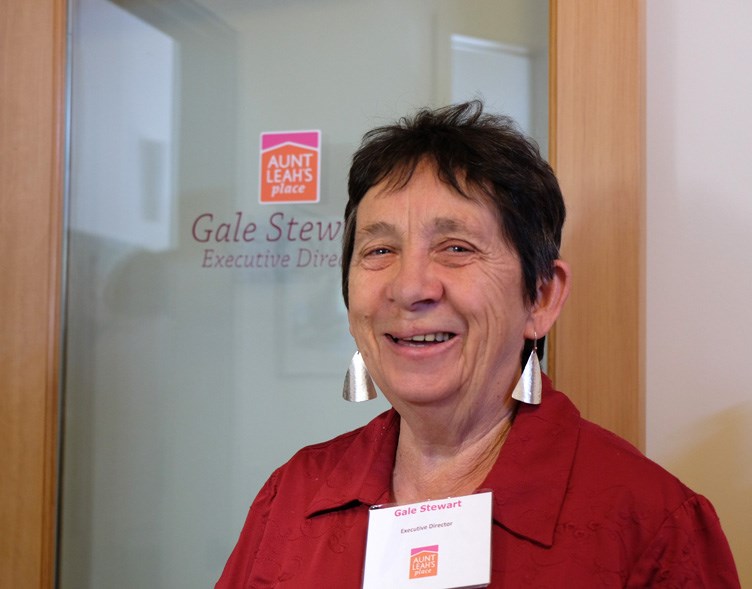A young woman found a sense of family and belonging at Aunt Leah’s Place – something she never had at home.
A ward of the government since the age of seven, Shanee moved into Aunt Leah’s House when she became pregnant at 15 and the ministry couldn’t find a foster family willing to take in a mom-to-be.
“I have been coming to Aunt Leah’s ever since,” she said. “I come from a family of addicts. My mom and brother are the only family I have in Canada. They are both addicts on the east side.”
Shanee is sure she would have followed a completely different path had it not been for the support of Aunt Leah’s. Now 27, she recalls how Aunt Leah’s staff was there for her during the birth of her children and on graduation day.
“No family was there, but Aunt Leah’s was there,” she told The Record. “That was probably the most emotional part for me was seeing them there. It was a huge accomplishment for me – and they were there.”
As youth transition into adulthood they often have the support of their families – but that’s not the case for the hundreds of children who age out of foster care in British Columbia each year.
Researchers from the University of Victoria have released a study showing that a New Westminster-based program is effective at helping former foster-care youth avoid homelessness after losing their government support when they turn 19. Aunt Leah’s Place, a nonprofit society, held a press conference June 9 to show off its newly opened head office on 20th Street and to release the study, Avoiding the Precipice: An Evaluation of Aunt Leah’s Link program in supporting youth from foster care.
“What is Aunt Leah’s? It is an organization that offers at-risk youth a very much-needed place to call home,” said Ivery Castilloux, who received support through the Link program. “Home is where you go when you need help, when you are down on your luck or simply need a full stomach.”
No matter who you are, how old you are or where you come from, Castilloux said everyone has the propensity to tumble over that precipice. The difference with foster children, he said, is they often don’t have anyone to soften the blow.
Gale Stewart, founder of Aunt Leah’s Place, hopes the study by researchers at the University of Victoria will allow Aunt Leah’s to be better advocates for the youth it serves and will help lead to legislative changes that will see supports extended to youth in foster care beyond the age of 19.
The Link, one of several programs for youth offered by Aunt Leah’s, provides youth who have aged out of foster care with a support worker who helps them look for employment and educational opportunities, find safe, affordable housing, and learn skills such as budgeting and meal planning.
Stewart founded Aunt Leah’s Place back in 1988 with a project for teen moms, eventually adding programs to help prevent children in foster care from becoming homeless.
“We do specifically help foster children learn skills so they don’t become homeless, and we help teenage moms and homeless moms on their journey to continue to be able to support their children,” she said. “So it’s like the two ends of the spectrum. Those children who are coming out of foster care, we help them with housing, employment and education so they don’t become homeless, and we help the young moms … so they don’t lose custody of their children.”
Every year, about 700 youth age out of foster care in British Columbia.
Deborah Rutman of the University of Victoria school of social work was a lead researcher on Avoiding the Precipice. She said 42 per cent of youth up to age 29 live in the family home and 50 per cent in the 20 to 24 year age bracket live at home, so the transition to adulthood is quite gradual and is extended.
“For most kids in foster care, the transition doesn’t exist,” she said. “You are cut off from the government support you’ve had, that you’ve been living with, both in terms of your living situation and in terms of the connection to youth services. Those end as well. As a process, it is denied. It ends.”
Despite life situations that brought them into foster care and experiences while in care, Rutman said those kids are expected to transition into adulthood with fewer resources than most young adults with parents.
According to Rutman, national research suggests that 40 per cent of youth who are homeless have been in foster care. Aunt Leah’s developed the Link program to provide youth who are aging out of foster care with the same programming supports and trusted people they were working with before they turned 19.
The study looked at youth who had aged out of foster care and attended the Link program, and youth who aged out of foster care and attended no program. The study found youth involved in the program were more likely to graduate from school and more likely to become homeless.
“There is no age limit to this program,” Rutman said. “It doesn’t stop at age 24 or 25, which unfortunately tends to be the norm, even for youth-serving programs.”
Like parents support their children in a myriad of ways, she said the Link program staff support kids in different ways and don’t focus on one specific issue.
“It is a family environment,” Rutman said. “It is an open door. People feel welcome and accepted when they come here. That’s hugely important.”
The study found that Aunt Leah’s Link program is relatively low cost and is making positive impacts on the people it serves and society overall. Some of the recommendations of the report include: continuing funding for The Link; expanding the program into areas where program participants live, including Surrey; and extending the age of government care-related supports to young people to the age of 24.



